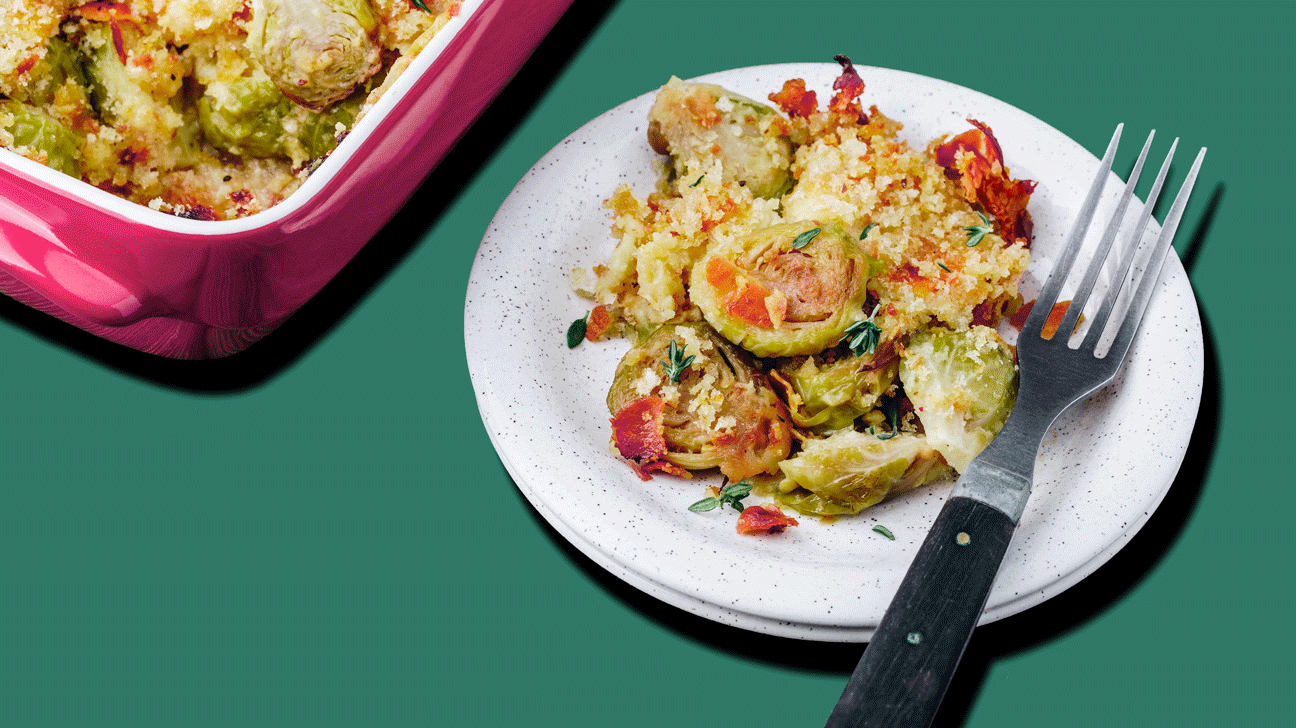
Sorry to burst a Barbie-sized bubble, but no, these sprouts are not actually baby cabbages. However, they are in the same family, the Brassica, or cruciferous family. Other members include kale, broccoli, cauliflower, collard greens, turnips, mustard, and bok choy. With cabbages, we eat the head that grows out of the ground. Those heads, which can be round, conical, oblong, or pointed, can each weigh between 1 and 12 pounds. With Brussels sprouts, we eat the buds from a long, thick, fibrous stalk.
Brussels sprouts basics
To you haters out there, we swear Brussels sprouts don’t taste like dirty socks when you roast, stir-fry, or even steam them—if you don’t overdo it. The sulfurous smell that wafts from overcooked, especially boiled, Brussels sprouts come from the compound glucosinolate sinigrin, which also has cancer-fighting qualities.
Brussels sprouts got their name because Brussels, the capital of Belgium was where the modern version of the vegetable was first cultivated, sometime around the 16th century. They have a long growing season, from spring to fall, and thrive in colder climates. These little vegetables range from the size of walnuts to golf balls and are packed with nutrition, from fiber, protein, and potassium to vitamins A, C, and K.
Cabbage is one of the oldest recorded vegetables in history, with more than 100 varieties. The most common varieties in the United States are green, crinkly-leaved Savoy; smooth-leaved green; and red cabbage, which looks purple to some of us. (It’s the color of purple eggplant, no?) The head isn’t always shaped like a, well, head. Sometimes it’s flattened or pointed. Cabbage also doesn’t mind cooler climates, but the length of its growing season is shorter. Nutritionally, cabbage is similar to Brussels sprouts, but it has more calcium and less potassium.
According to the University of Maine Extension, those little Belgium dudes have twice the amount of vitamin C as their larger cousin does, so excuse them for farting sometimes. Although not quite as foul, cabbage also contains sulfur, emitting an undesireable odor when you boil it forever. So just don’t. Brussels sprouts are pretty bitter when eaten raw, but cabbage is quite mild, as anyone who’s used cabbage as a wrap or in a slaw knows.
Store Brussels sprouts unwashed and covered in the fridge for up to five days, and store cabbage unwashed and in a plastic bag or container in the fridge for up to two weeks.
Recipes featuring Brussels sprouts and cabbage
We have so many ways of cooking cabbage and Brussels sprouts correctly, you gotta try a few this fall. Here’s a handful of our top picks:
1. Chicken Larb Cabbage Cups with Sriracha, Lime, and Green Beans
We like this recipe because of the word “larb.” It sounds cool. Just kidding. Larb is a Thai or Lao spicy ground meat salad dish, typically stir-fried with flavorings like lime, chiles, mint, fish sauce, and green onion. Oh, and it takes about 35 minutes to make, so that sits well with us. While steamed rice is always nice, cabbage leaves make a cooling, crunchy, low-carb vehicle that also doesn’t dirty another pot. Get our chicken larb recipe.
2. Brussels Sprouts and Lemon Risotto
The little guys are sliced into slivers and sautéed in oil with lemon juice zest for bright flavor, and then they’re mixed with plumped figs and creamy risotto. Get our Brussels sprouts and lemon risotto recipe. If you have any leftover, form it into cakes straight from the fridge, dip it in beaten egg and panko, then pan-fry for delicious creamy-inside, crispy-outside cakes for dinner. Just add a salad on the side.
3. Broccoli Slaw
Raw green and red cabbage mixed with bagged, shredded broccoli works so well when you add Greek yogurt, cranberries, and walnuts. Get our broccoli slaw recipe. Serve alongside any roasted meat.
4. Shaved Brussels Sprouts Salad
Remember when we said raw Brussels sprouts are bitter? Well scratch that in this case. With judicious additions of lemon juice, pine nuts, hard-boiled egg, and cheese, they’re anything but. Get our shaved Brussels sprouts salad recipe.
5. Potato and Cabbage Hash (Colcannon)
Twice-fried potatoes, buttery onions, and cabbage left still a little crunchy makes this an Irish treat that’s too delicious to reserve only for St. Patrick’s Day. Get our potato and cabbage hash recipe.

0 Commentaires